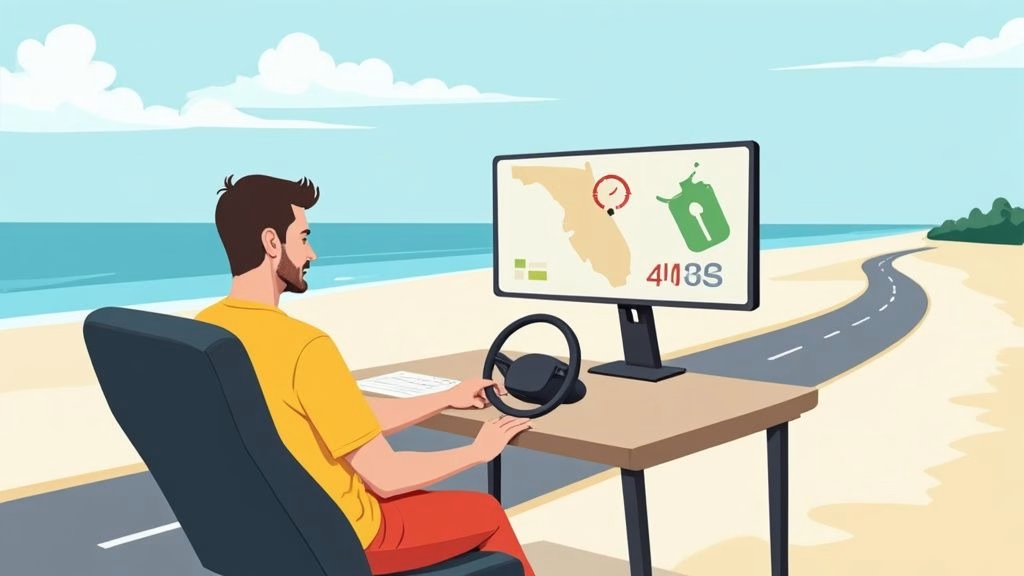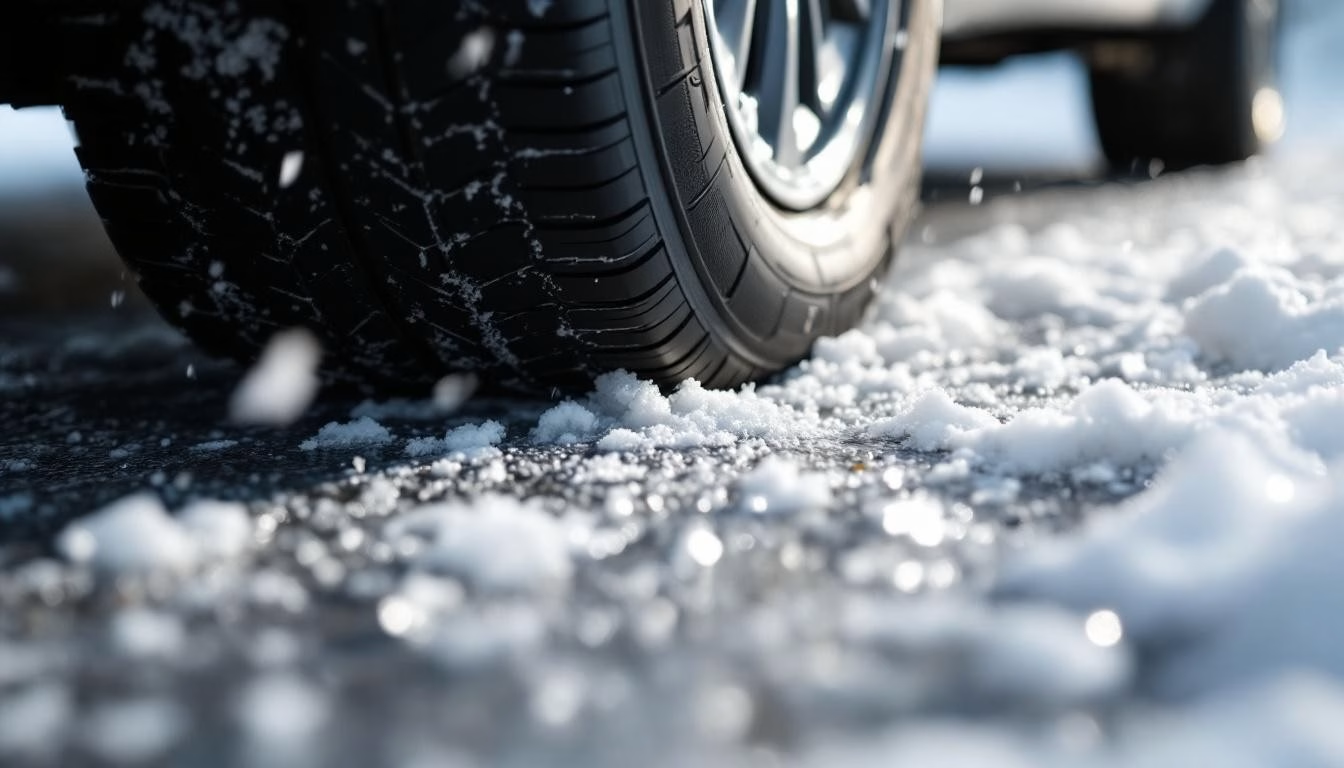Winter weather transforms familiar roads into hazardous terrain. According to the Federal Highway Administration, 24% of weather-related vehicle crashes occur on snowy, slushy, or icy pavement.
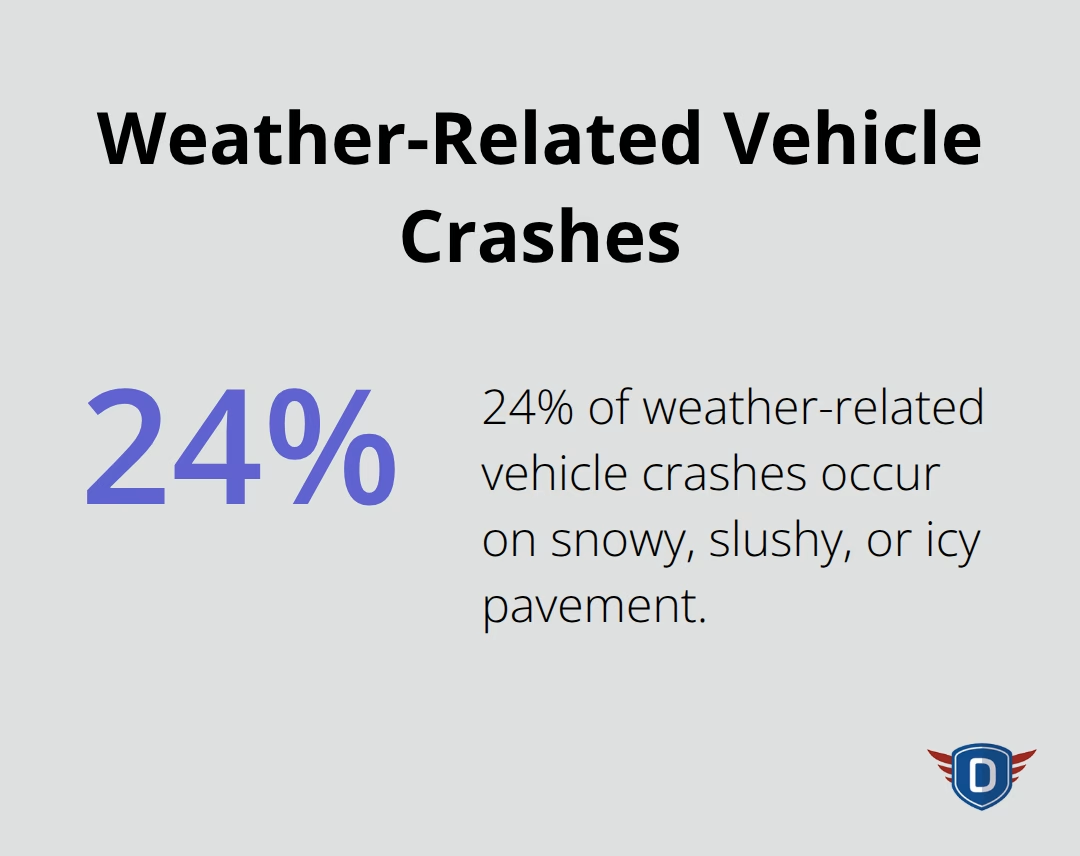
We at floridadetscourse.com compiled these safe driving tips winter conditions demand. Proper preparation and technique can prevent accidents and save lives during harsh weather months.
What Should You Check Before Winter Arrives
Tire Selection and Maintenance
Your vehicle needs three critical upgrades before winter weather strikes. The National Highway Traffic Safety Administration reports that proper tire tread depth should measure at least 2/32 of an inch for winter safety, but smart drivers replace tires at 4/32 of an inch. Winter tires outperform all-season options below 45 degrees Fahrenheit because their rubber compounds stay flexible in cold temperatures. All-season tires harden and lose grip when temperatures drop, which makes them dangerous on snow and ice.
Monitor tire pressure monthly during winter since it drops approximately one PSI for every 10-degree temperature decrease. Cold weather affects tire performance more than most drivers realize.
Battery and Electrical System Testing
Battery performance drops significantly in cold weather, with power decreasing by up to 50% in freezing conditions. Have your battery tested at an auto repair shop with a load test to verify it can handle cold starts. Replace batteries older than three years before winter begins (most batteries fail between years three and five). Check your coolant system and replace windshield wipers with winter blades that resist ice buildup.
Emergency Kit Preparation
Stock your emergency kit with wool blankets, non-perishable food, water, jumper cables, a flashlight, and a small shovel. Keep kitty litter or sand in your trunk for traction if you get stuck. These supplies can mean the difference between minor inconvenience and serious danger during winter emergencies.
These preparation steps set the foundation for safe winter travel, but proper technique behind the wheel matters just as much as vehicle readiness.
How Do You Master Winter Driving Techniques
Speed Control and Following Distance
Reduce your speed to two-thirds of normal on snow-covered roads and half speed on ice, according to the National Safety Council. The Federal Highway Administration data shows that average speeds drop by 30% to 40% on snowy pavement and up to 40% in heavy snow conditions. Increase your following distance to at least four seconds in winter conditions (which equals more than half a football field when you travel at 30 mph). Most drivers fail to adjust their following distance adequately, which creates dangerous situations when they need to stop suddenly. Test your stopping distance in an empty parking lot before winter arrives to understand how much longer your vehicle needs to stop on slippery surfaces.
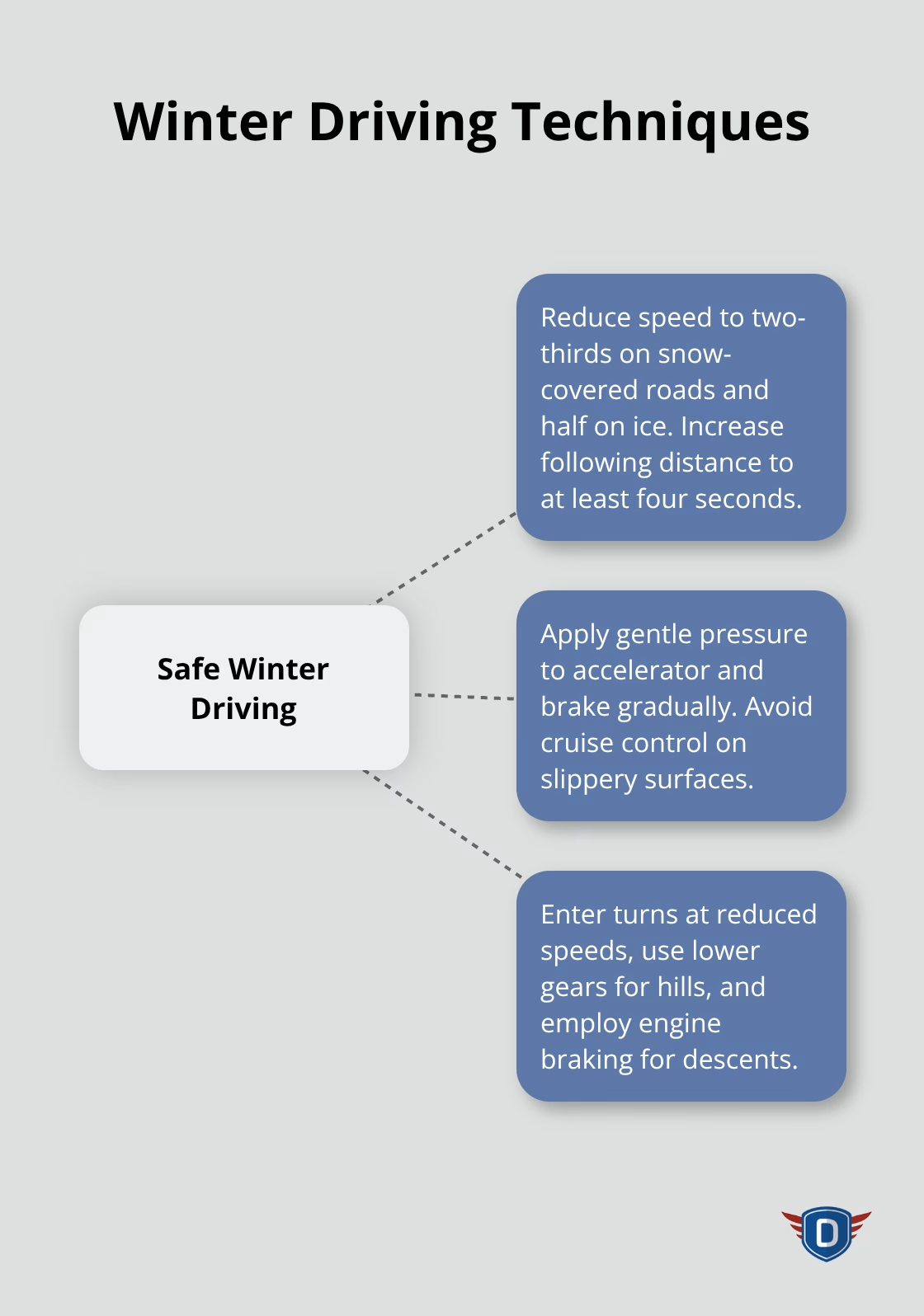
Smooth Acceleration and Braking Techniques
Apply gentle pressure to the accelerator when you start from a stop to prevent wheel spin and maintain traction. Sudden acceleration causes tires to lose grip and creates dangerous skids. Brake gradually and steadily rather than pump the brakes, even with anti-lock brake systems. Press the brake pedal firmly and let the ABS system work rather than fight it with pumps. Avoid cruise control on any slippery surface because it prevents you from making quick adjustments to changing road conditions. The vehicle’s computer cannot react to ice patches or snow accumulation as quickly as an alert driver can.
Cornering and Hill Navigation
Enter turns at reduced speeds and avoid sudden steering inputs that can cause skids. Gentle steering movements help maintain tire contact with the road surface. Use lower gears when you climb hills to maintain steady power without wheel spin. Shift to a lower gear before you start your climb rather than during the ascent when you might lose traction. Descend hills slowly and use engine braking (downshift to a lower gear) to control your speed without overheating your brakes.
These techniques work best when you practice them regularly, but even experienced drivers face situations where their vehicle loses control or gets stuck in winter conditions. Mastering defensive driving techniques helps you anticipate hazards and respond appropriately to challenging winter road conditions.
What to Do During Winter Emergencies
Getting Unstuck from Snow
Turn your wheels side to side to push snow away when your vehicle gets stuck, but never spin your tires aggressively. The American Automobile Association reports that aggressive wheel spinning creates polished ice under your tires and worsens the situation. Pour sand, kitty litter, or rock salt in front of your drive wheels to create traction. Rock your vehicle gently by shifting between drive and reverse while you apply light gas pressure. Check your owner’s manual first because some automatic transmissions suffer damage from this technique. Clear snow from around your exhaust pipe to prevent carbon monoxide poisoning while your engine runs.
Controlling Skids and Vehicle Recovery
Steer in the direction you want your front wheels to go when your rear wheels skid, according to the National Highway Traffic Safety Administration. Take your foot completely off the gas pedal and avoid hitting the brakes during a rear-wheel skid. Front-wheel skids require different action: shift to neutral, take your foot off the gas, and wait until you regain traction before you steer again. Make small corrections rather than large jerky movements that can send you into an opposite skid.
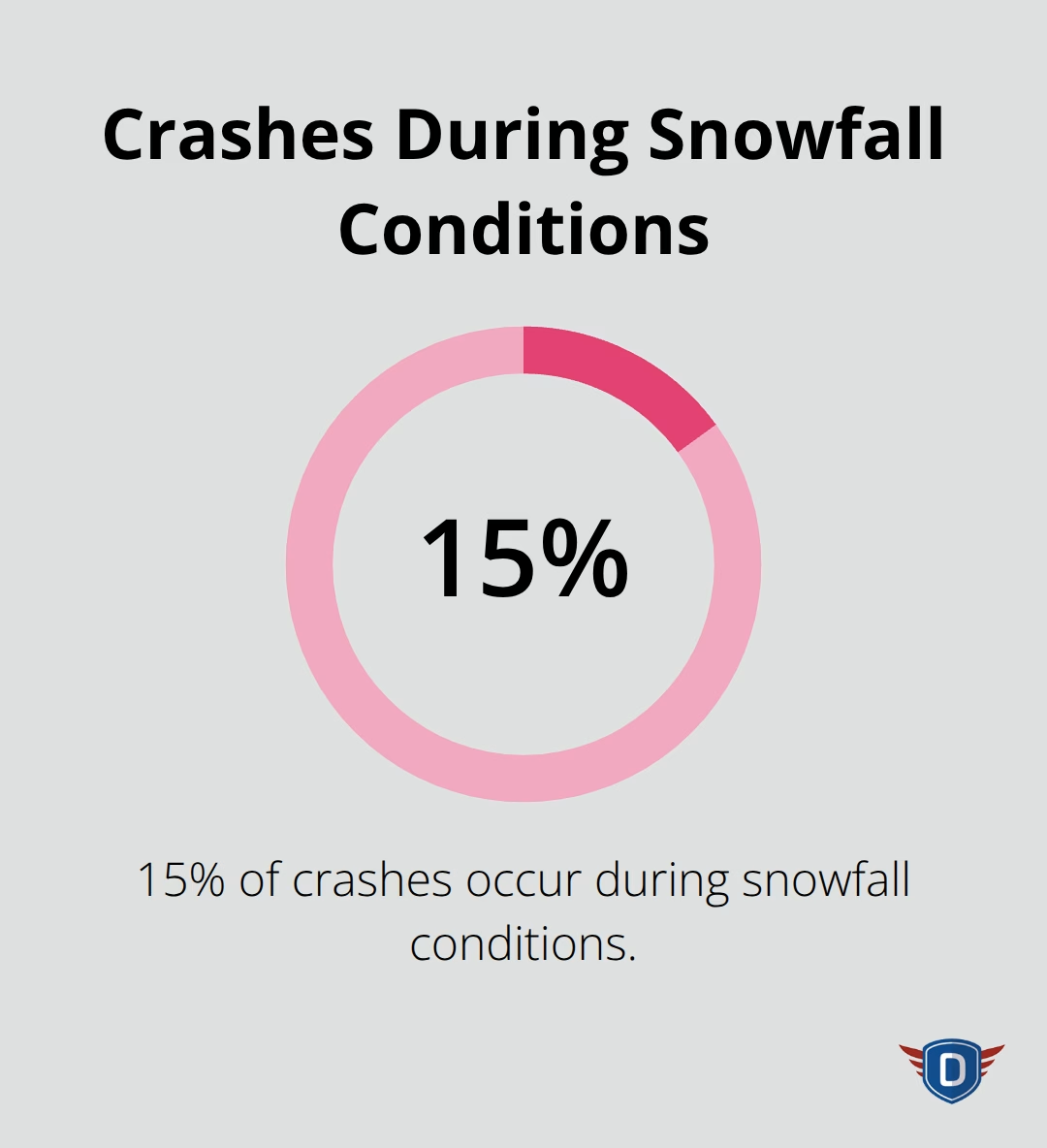
Severe Weather Shelter Decisions
Pull over immediately when visibility drops below 100 feet or when snow accumulates faster than plows can clear it. The Federal Highway Administration reports that 15% happen during snowfall conditions. Find the nearest exit or safe area rather than stop on highway shoulders where other vehicles might hit you. Keep your hazard lights on and run your engine for 10 minutes every hour to stay warm while you conserve fuel (crack a window slightly for ventilation and check that snow doesn’t block your exhaust pipe). Call for help but stay with your vehicle because rescue crews spot cars easier than people who walk in storms. Keep your gas tank full throughout winter travel since fuel lines can freeze, and electric vehicle owners should maintain charged batteries. Practice the manual door unlock procedure in daylight conditions so you can execute it quickly during nighttime emergencies.
Final Thoughts
Winter conditions kill over 1,300 people annually in crashes on snowy, slushy, or icy roads. These statistics make preparation and proper technique essential for winter travel. Safe driving tips winter conditions require become life-saving skills when weather turns dangerous.
Your vehicle needs battery tests, tire inspections, and emergency kit preparation before cold weather arrives. Speed reduction and increased following distances protect you against winter hazards better than any other technique. Even four-wheel drive vehicles lose control on ice, so overconfidence proves more deadly than poor preparation.
We at floridadetscourse.com provide professional driver education that builds the confidence and competence necessary for safe winter travel. Our certified instructors offer personalized guidance to help you develop winter driving skills. Practice these techniques in safe environments before you face them on busy roads during storms.



